The second leg of the UEFA Champions League quarter-final between Borussia Dortmund and Manchester City was played in Germany on Wednesday night. In the first leg, Edin Terzić sides came with good tactics and the mentality that surprised people. The Citizens merely won at the final stages of the game by the goal of Phil Foden.
Before the game, or even in the 20 minutes of the game, Dortmund might give the impression that they had the chance to qualify and facing Paris Saint-Germain. However, Pep Guardiola got his tactics right this time to grab the game in his own hand. Eventually, Manchester City won the tie with a 4-2 victory in aggregate.
City played better in this game compared to the previous one. The tactical analysis will show how the guests adjusted the game plan to minimize their weaknesses. This time, Terzić’s tactics were outplayed by Pep without workable solutions throughout the game.
Lineups
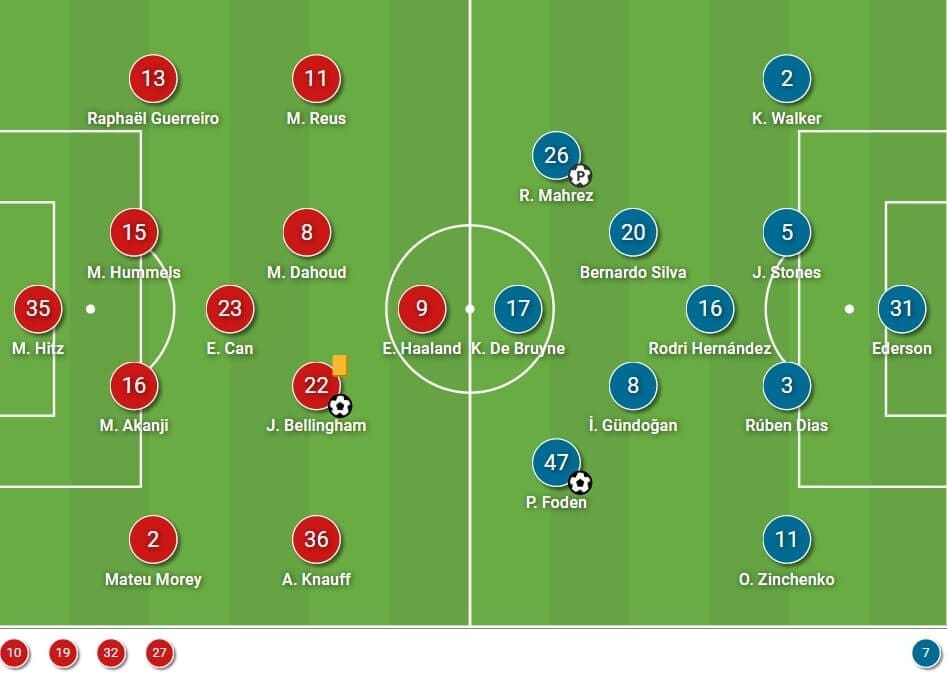
Terzić played the exact same formation as he did at the Etihad. Despite having more experiences, Thomas Meunier could not regain his place at the starting lineup. Meanwhile, the caretaker manager insisted on playing Emre Can alone at the midfield with Mahmoud Dahoud and Jude Bellingham playing higher. It was a bit of surprise as Thomas Delaney, who was better at defending did not start any of the game.
City also came with a similar formation but there were a few changes that should be noted. João Cancelo lost his place because of inconsistency after the international break. Oleksandr Zinchenko stepped up to play as the left-back. Another change was less obvious but proved to be vital – Kevin De Bruyne played higher as Bernardo Silva joined Rodrigo Hernández and İlkay Gündoğan at the midfield. It was a reverse setup compared to what they did in the previous game.
City pressing differently to restore balance
In the first leg, City suffered a lot without the ball as they failed to nullify the offensive threat of Dortmund. Their 4-2-4 pressing led by Silva and De Bruyne was unable to cope with the numerical superiorities of the oppositions. The biggest issue was spacing left behind the two midfielders as they could not stop Erling Håland and Dahoud from receiving the ball.
Therefore, Pep changed the pressing system a lot in this game, the focus was to avoid the above situations happening again. Despite conceding a goal early, the defence of City were able to largely limit the attack of Dortmund.
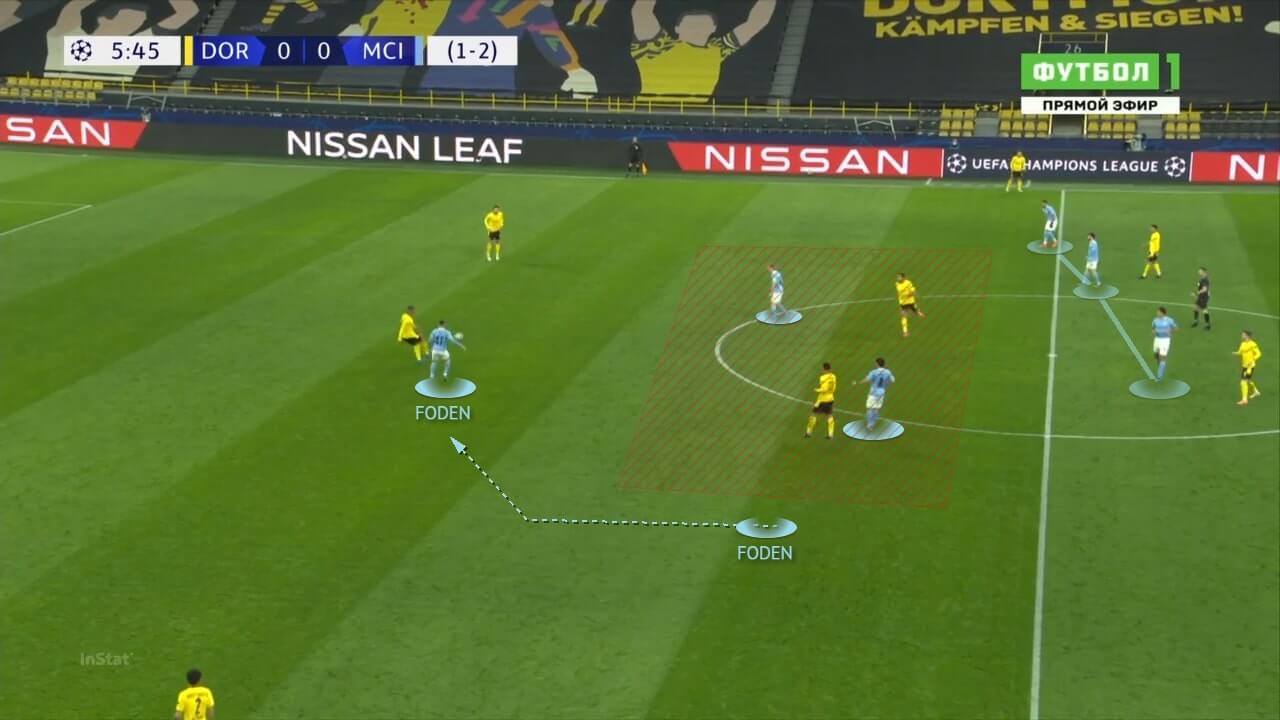
The first thing Pep has done was lowering the engagement line to avoid players defending in large spaces. The Citizens defended deeper but with more compactness, especially maintaining a central overload at the centre to close all spaces inside. This would block Dortmund’s entry to spaces behind their midfield, forcing the attack sideways or going behind the defence.
City changed by using the wingers to initiate the press in this game (it was the striker in the first leg). By pressing from half-spaces and curving the runs at the same time, City could shut the outside passing lane, forcing the ball to either vertical half of the pitch. The above image shows Foden applying pressure on the right centre-back, his run would cover the passing lane to the right-back.
Meanwhile, the most important was to have more players at the midfield. In the red zone where they lost a man in the first leg, now they had a 2v2 numerical equality given De Bruyne and Silva stayed in the zone. Behind of the duo, there was a three-man layer to defend spaces at the centre, so Dortmund could not loft the ball or passing vertically into that zone as each passing lane was narrowed.
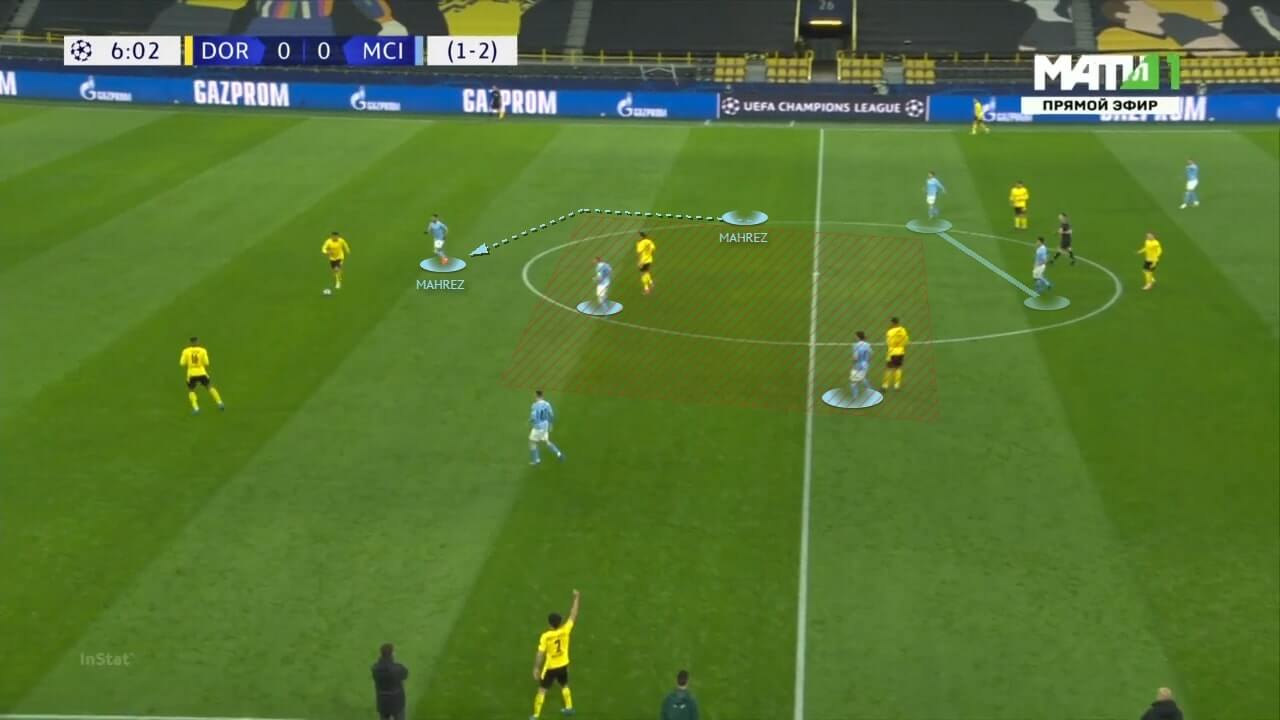
Another example, this time the pressing initiator was Riyad Mahrez from the right. His curve runs began from half-spaces had close Mats Hummels’ angle to the left-back. He was forced to play the ball to Dortmund’s right or behind the defence. But if he went right, City had Foden waiting for another wave of pressing already.
Again, in the red zone City would maintain a 2v2 numerical equality as De Bruyne did not have to step up on the centre-backs. This setup was crucial as City had given the likes of Can and Bellingham too many spaces to play in the last clash. Also, the curve runs that shut the passing lane to the outside would stop the full-backs from receiving the ball, which they failed to do so and suffered previously.
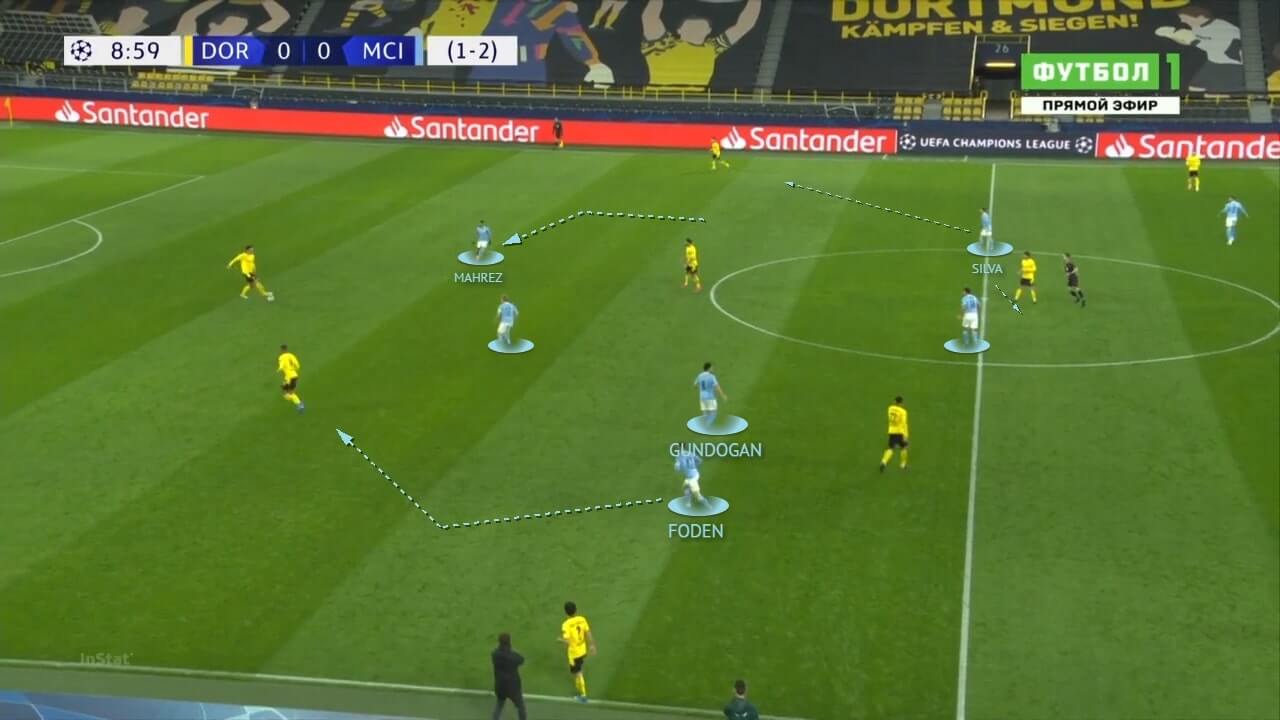
As suggested in the above analysis, swapping De Bruyne and Silva’s positions was pivotal as this decision balanced the team. When both were pressing high in the previous game, City failed to control spacing around the central circle, but they managed to do that after this switch.
This image would give us some hints. The pressing from Foden and Mahrez were the same elements, they began from the half-spaces and curving the runs to apply pressure on the centre-backs. The impacts of these behaviours were explained in the above example.
We wanted to point out the function of Silva. The Portuguese international carried specific defensive duties in the game which City did not show in the previous game. You could see how he predominantly staying at the centre to close that zone with Rodri. However, he also had the awareness to access the opposition left-back in case Mahrez’s shadowing efforts did not work. In other words, Silva was defending to oppositions at the same time, being flexible to adjust his positions to cope with the situations. This would give the front players more confidence to press, especially since the wingers knew there would be cover when they committed themselves.
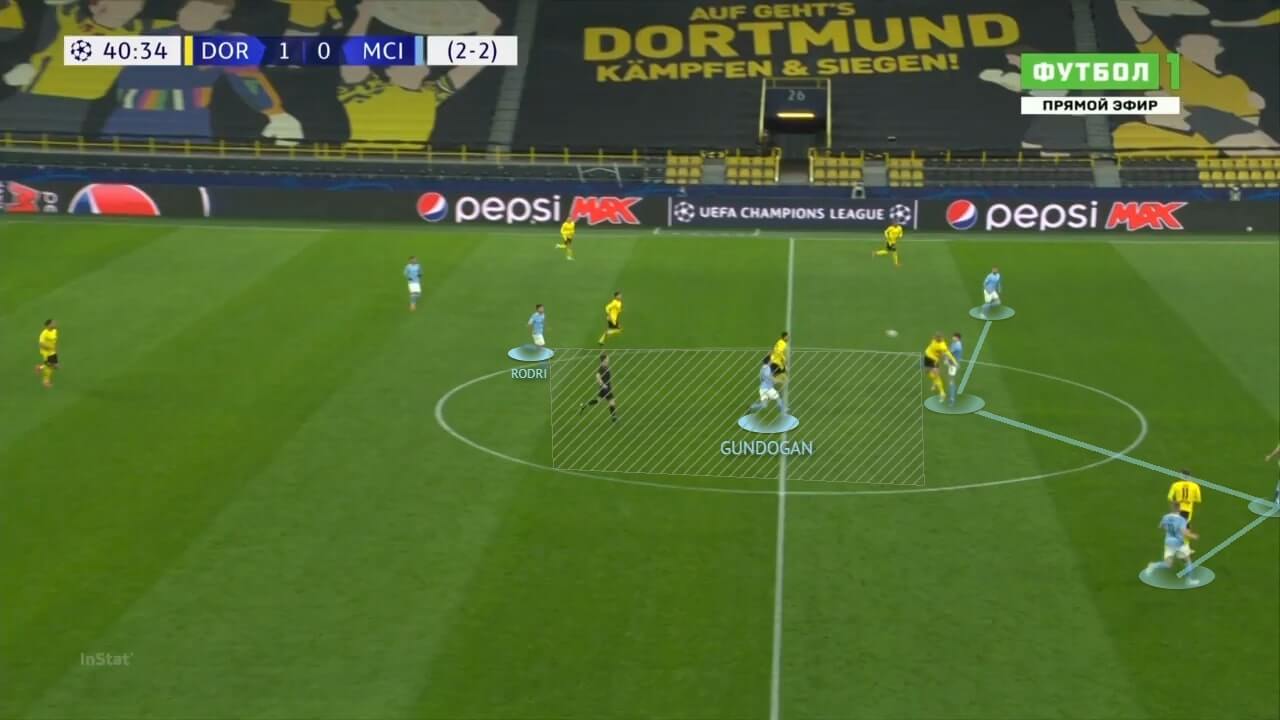
Another key factor that led to the adjustment was the spacing issue we raised in the first paragraph in the section. Pep intended to solve the issue by keeping midfielders deeper and closer to the defenders, and here we show you the effects of the changes.
Since the initial setup of the press would force Dortmund to play long balls forward, the most important was to know where to defend and to react in different situations. When Håland was the target, the nearer centre-back must compete with him aerially, but the other one should stay deeper to cover all possible runs behind. Hence, the shape of City’s defensive line was zigzagged in the screenshot when John Stones engaged, Rúben Dias dropped.
Playing with deeper midfielders could allow Gündoğan and Rodri to stay deeper. When the long ball came, they could arrive at the highlighted zone on time to fight for the second balls. It was a 3v3 in this situation, Dortmund were unable to regain their “+1” advantage as they did in the first leg. On most occasions, City defended targeted long balls well, but just on one occasion when the long ball hit into spaces behind, they conceded the goal. This would be a department they needed to keep improving as PSG were expected to attack spaces behind a lot too.
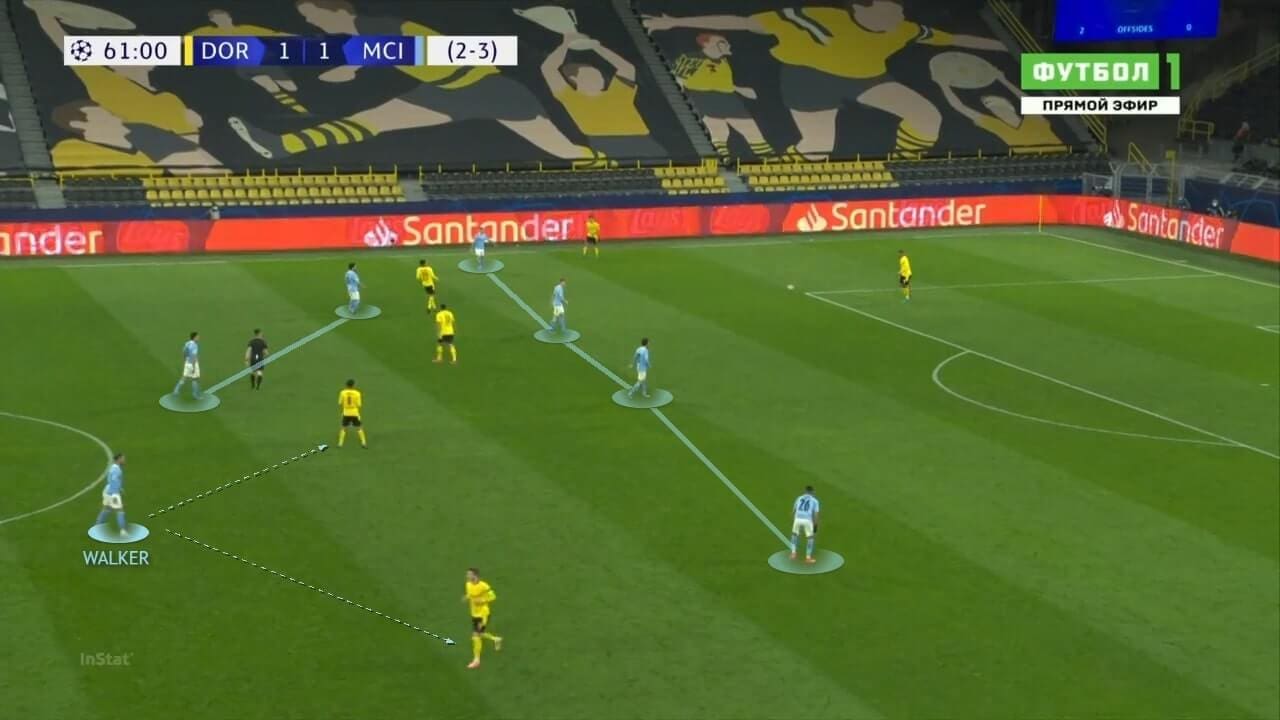
Another solution for Pep to close spacing at the centre was freeing the full-back to help. There would still be situations when Rodri and Gündoğan stepped up, resulting in a 4-2-4 shape. However, you could see Kyle Walker in this example has moved into spaces inside, slightly behind the midfield duo. This has given extra protection to the spaces inside and behind the midfielders.
Pep was braved to make this change as he allowed the full-back to not tightly marking the opposition wingers. Previously, Dortmund pinned the City full-back and Walker would not be leaving his target easily in the first leg. Like what we have shown in the Silva example, Walker would have to position himself wisely to keep accessible distances to more than one player.
Pep’s change saves the day
Offensively, City were bad at the first 20 minutes of the game. It seems some of Pep’s ideas did not work. The biggest issue was the overcrowded wide zones when the wingers and the full-backs were too close to each other. Thus, the Citizens struggled to create before the conceded goal as lacking options around the ball when the attack was forced sideways.
Of course, Pep and his coaching staff were sensible enough to make changes early, we will show how they fix the issues to engine the troops again in this section.
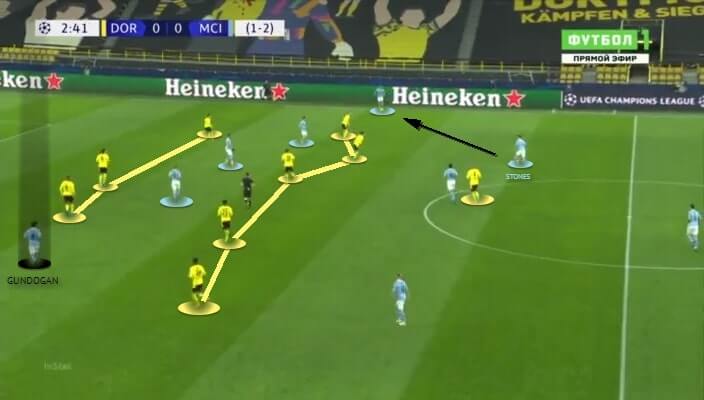
Dortmund set a 4-5-1 block in their half, City planned to play with multiple players between the lines to exploit this three-layer defence. However, to avoid losing possession at the centre which could lead to dangerous counter-attacks, the Citizens were reluctant to play vertical passes through the narrowed passing lane. In the early stages, there were a lot of sideway passes from centre-backs to the outside, which was not effective.
This example shows Stones playing to Walker as we want to indicate the wide passes of City in the early stage. You could also notice there was plenty of sky blue shirts staying between the lines. Also, look at Gündoğan’s position, we will show you the changes later.
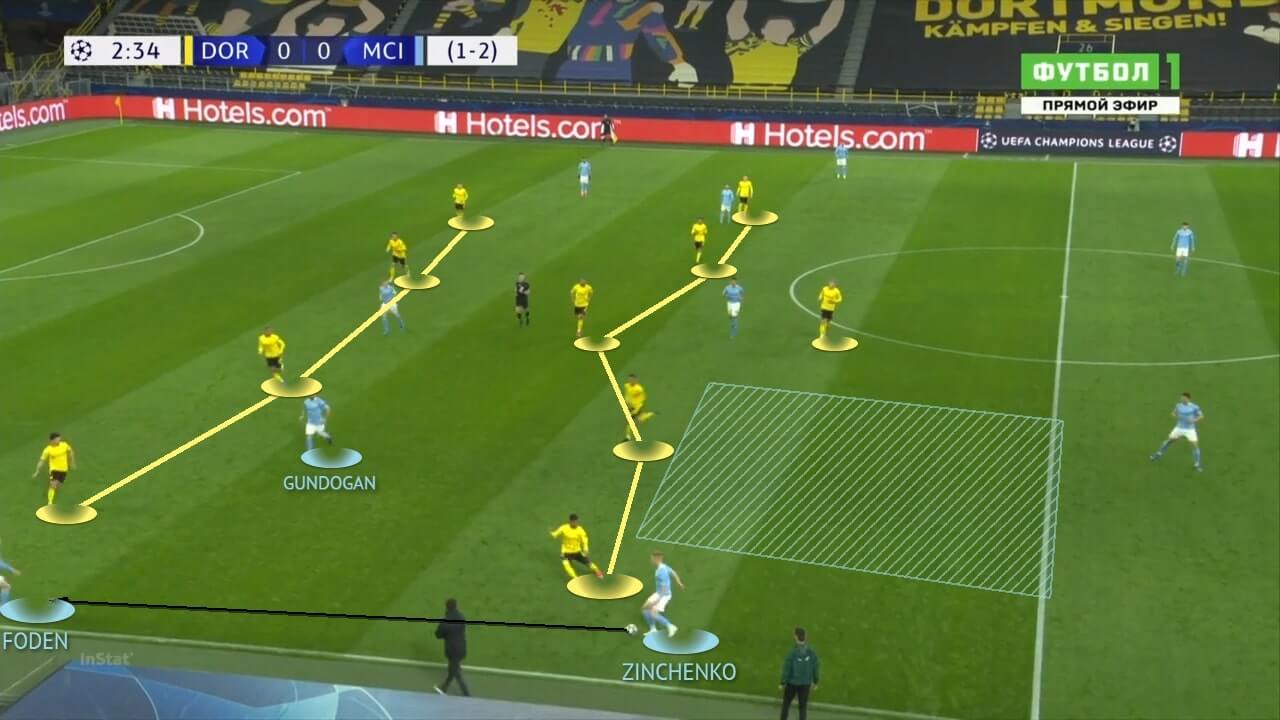
The issue of City was the winger squeezing spaces for the full-backs, which was the situation in this image. Foden and Zinchenko stayed in the same zone, so the Ukrainian international not even positioning higher than the second defensive line. When he was too deep, there was no room to pass into half-spaces, so basically Gündoğan would not be able as an option.
Also, full-backs passing to wingers vertically was not ideal as this led to closed bodies and invited pressure while the attack was bounded by the touchline. The pass from Zinchenko to Foden would not offer progression here as the Dortmund right-back was out early to press.
Instead, Zinchenko needed a circulation option in the highlighted zone but they did not have the right player to move into that space. Dias’s role as the rest defence was inarguable, he was not expected to step up into that zone as he should be the deepest man to cover all the time. Meanwhile, Rodri was largely marked by the striker and immobile, so he should not be that circulation option as well.
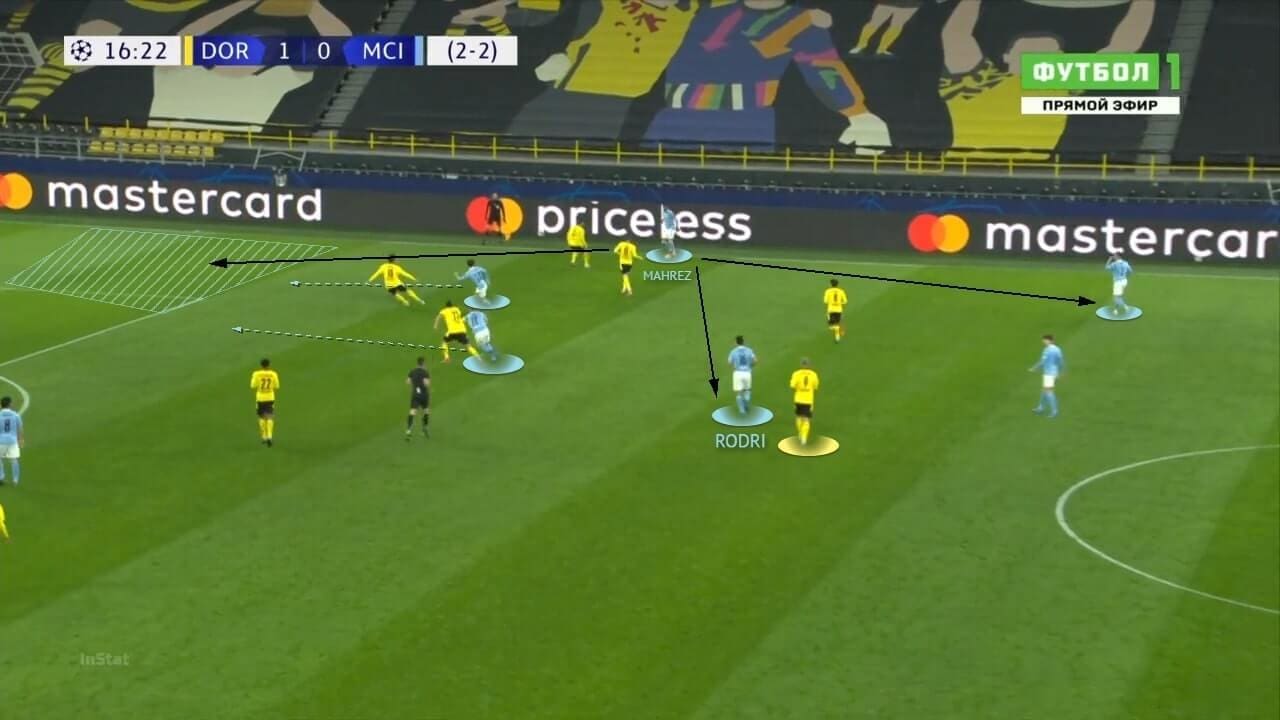
City also experienced similar situations on the right. On this occasion, Mahrez had the ball and you could see Silva and De Bruyne running into spaces behind. The issue was they did this together, they attacked the same space, it was very easy to defend. Also, spaces pre-occupied by De Bruyne and Silva would be left open but without any City player to exploit.
Similar to the previous example, Rodri was not the man to support the ball in these situations, while Walker was a backward passing option. Hence, we can conclude that when City’s attack reaching the wide zones, they struggled to get back to half-spaces laterally to play the final passes. Even getting Gündoğan into the box to look for the chances was not useful as they even struggled to create.
Of course, Pep came with his solution, and this settled things very well.
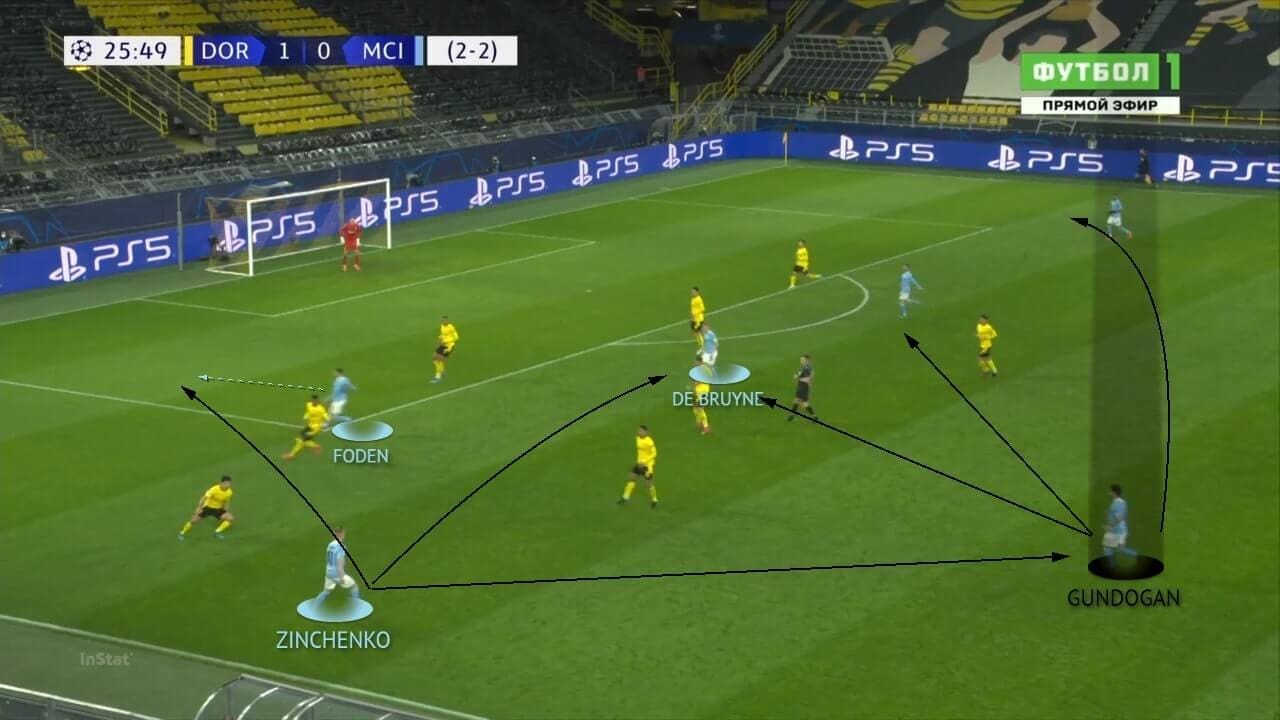
The solution was playing Gündoğan with Rodri at the midfield – the strategy they used a lot in the previous season. This would allow the German international to support the ball in a deeper area, which means he would be free to receive when the other front players pushed the defensive lines deeper. Also, City wingers started to play narrower at half-spaces, leaving the wide zones for full-backs to receive higher, which could create more spaces for the full-backs.
This image was a very similar situation but there are more positives after the changes. Now, Zinchenko received higher and had the angle to pass, and he did not lack the passing options. Foden made the forward run to offer an option behind, De Bruyne coming from inside to receive between the lines, but the most important support was Gündoğan, who could receive deeper now. When he received the ball from Zinchenko, he could have a good body angle to pass, also being able to develop the attack at the centre. It would be difficult to predict the German international’s next action as he had the most options inside, City could move the ball better to move the opponents, of course, for the sake of finding spaces.
In addition, the forward runs at half-spaces were proved to be a good way to attack Dortmund’s box. Some of City’s attack was attributed to this kind of runs after the tweak of Pep.

You could discover similar scenes in the second half as well, in which Gündoğan played deeper to help Rodri in the build-up. As we indicated above, now the full-backs were tasked to provide the width, Silva and De Bruyne would manipulate the second line. Hence, the point(s) of offensive heights should be provided by Foden and Mahrez. The structure of City changed hugely compare to what we have seen in the initial setups.
Final remarks
The improvements of City were clear such as the calmness they have shown during deficits. In the old days, even creating high-quality opportunities, their poor finishing would let them down. Now, they were different, being able to adapt to the situations and played their own football. As shown in the analysis, Pep’s work and change of tactics were pivotal to City’s success after arousing worries in the first leg.
After levelling with Mahrez’s penalty, City had more and more opportunities in the transitions. Dortmund’s backline was forced to be exposed when committing numbers to join the attack high. When Foden scored the goal, the game was dead, and City are through. In general, the Citizens were good in the game except for the first 20 minutes. They deserved to be in the semi-final and more tests await!





Comments